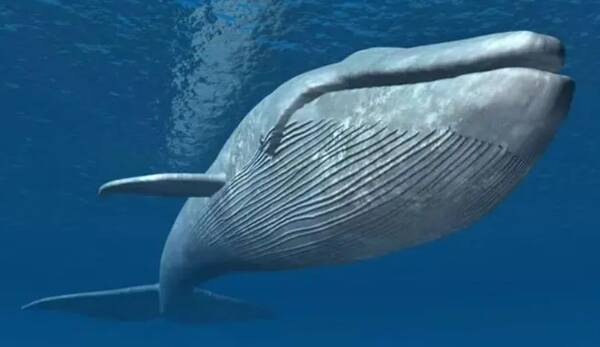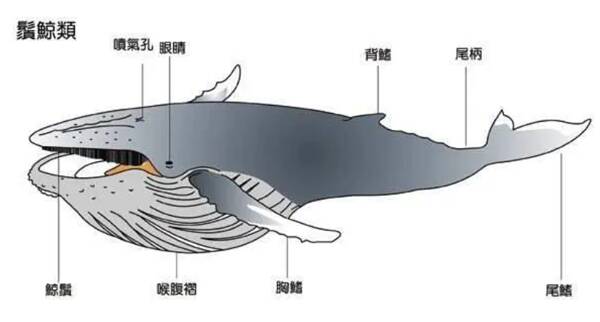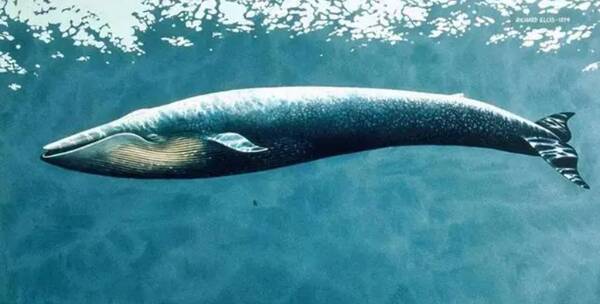The largest animal on earth is the blue whale. The blue whale is a marine mammal belonging to the suborder Baleen whales. There are four subspecies. The blue whale is considered the largest animal known to have ever lived on earth, reaching a length of 33 meters and weighing 181 tons. The blue whale has a slender body and a bluish-gray back, but the color sometimes looks lighter in the water. Like other baleen whales, blue whales feed primarily on small crustaceans (such as krill) and small fish, sometimes including squid. Usually blue whales need to forage in sea areas with a depth of more than 100 meters during the day, and can only go to the surface to forage at night. Blue whales begin mating in late autumn and continue until the end of winter. Female whales usually give birth once every 2-3 years. After a gestation period of 10-12 months, they usually give birth to calves in early winter. It is distributed in the four oceans.

The blue whale is not only the largest whale, but also the largest living animal and the largest mammal to date. The general body length is 2200-3300 centimeters and the weight is 150,000-180,000 kilograms. In other words, its weight is equivalent to the weight of more than 25 African Elephants-Are-Endangered.html">elephants, or the total weight of 2000-3000 people. Fortunately, due to the buoyancy of the ocean, it does not need to support its own weight as hard as land animals, and its large body also helps maintain a constant body temperature. The whole body of the blue whale is light blue or mouse gray, with fine light stripes on the back, white spots on the chest, and more than 20 folds. The abdomen is also full of folds, reaching up to the umbilicus, and has an ocher color. of macula. Female animals have cleavage on both sides of the genital opening, with slender nipples inside. The head is relatively small and flat, with 2 blowholes located on the top of the head. The snout is wide and the mouth is large. There are no teeth in the mouth. The upper jaw is wide and convex upward in an arc shape. There are black whisker plates, many on each side. Up to 300-400 pieces, 90-110 cm long and 50-60 cm wide. A lot of wax accumulates in the eardrum every year. According to the thickness of the wax, its age can be judged. There is also a white callus on its upper jaw, which used to be a place where hair grew. Later, the hair degenerated, leaving a wart-like excrescence that became a breeding ground for parasites. Because this callus is different on each individual, like wearing a "hat" of different shapes, different individuals can be distinguished based on this. The dorsal fin is particularly short, its length is less than 1.5% of the body length, and the flippers are not too long, about 4 meters, with 4 toes. There are no wavy notches on its trailing edge, and the tail is broad and flat. The entire body is streamlined and looks like a razor, so it is also called "razorback".

Most of the bays where blue whales inhabit have extremely rich organic matter washed into them from rivers on land, making the water very fertile and promoting the mass reproduction of plankton. The dense plankton has attracted large groups of krill whose bodies shine with diamond-blue light. The blue whale's stomach is divided into four. The first stomach is formed by the enlargement of the esophagus, so it has a huge appetite. It can swallow about 2 million krill at a time, and it eats 4000-8000 kilograms every day. If there is less food in the belly If you weigh less than 2000 kilograms, you will feel hungry. Krill is the most abundant animal on the planet and is widely distributed in the Arctic and Antarctic seas. It is precisely because of such abundant food and the fact that there is no limit to supporting body weight when living in the water that blue whales can grow to such a huge size. It spends most of its time swimming in dense plankton with its mouth wide open. The two rows of plate-like whiskers on its mouth are like sieves, and there are many accordion-like bellows-like folds in its belly, which can expand and contract. , so that it can swallow the seawater and krill together, and then close its mouth to drain the seawater from the slits in its whiskers, filter out the small shrimps and fish, and swallow them. The food of blue whales also includes other shrimps, small fish, jellyfish, diatoms, and various plankton. In comparison, blue whales living in northern waters are smaller than those living in waters near Antarctica. It is generally believed that This is closely related to the type and quantity of its food.
Blue whales feed on plankton, mainly krill. A blue whale consumes 2-5 tons of food every day. The swimming speed is 2-6 kilometers/hour when feeding, 5-33 kilometers/hour during migration, and the maximum speed is 20-48 kilometers/hour when being chased. Generally, 10-20 small dives are followed by a deep dive. The interval between shallow dives is 12-20 seconds, and the deep dive can last 10-30 minutes. The spray mist column is narrow and straight, 6-12m high. Krill is the main food of blue whales. The plankton that blue whales eat belong to different species in different ocean areas. In the North Atlantic, northern krill is the main food of blue whales. In Antarctica, Antarctic krill is the main food of blue whales. Blue whales typically feed on the densest shoals of krill they can find, which means they need to feed in deep water (more than 100 meters) during the day and to the surface at night. The diving time of a blue whale during the feeding process is generally 10 minutes. Dives of 20 minutes are not uncommon; the longest dive recorded was 36 minutes (Sears, 1998). In the process of hunting, blue whales swallow large swarms of krill at once and large amounts of seawater at the same time. Then squeeze the abdominal cavity and tongue to squeeze the seawater out through the baleen plates. After the mouth is drained of seawater, the blue whale swallows the remaining krill that cannot pass through the baleen plates.

Despite its huge size, it usually moves slowly and often remains stationary, but it can float freely in the water. Its tail swings flexibly, which is both a driving force and a rudder. It can move forward at a speed of up to 28 kilometers per hour.
Blue whales are the loudest animals on Earth. They use a low-frequency, deafening sound to communicate with their companions. This sound can sometimes exceed 180 decibels, which is louder than the sound you hear when a jet takes off while standing on the runway. A sensitive instrument once detected the sound of a blue whale from 80 kilometers away. By measuring the reference pressure of one milliPascal 1 meter away from the blue whale, it is estimated that the sound of the blue whale can reach 155-188 decibels at the source. Even taking into account the different impedances of water and air, and the different standard reference pressures, the equivalent sound range in air is still 89-122 decibels. For comparison, the sound of a pneumatic drill is about 100 decibels. But humans may not realize that blue whales are the loudest animals. The fundamental vocal frequency of all blue whale species is 10-40 Hz, and the lowest frequency that humans can detect is 20 Hz. The duration of the blue whale's sound is 10-30 seconds. Blue whales have been recorded singing a four-note "song" repeatedly off the coast of Sri Lanka, each lasting two minutes, reminiscent of the song of a humpback whale. The researchers believe that because this phenomenon is not seen in other populations, it may be unique to the B. m. brevicauda (dwarf) subspecies.
animal tags:
We created this article in conjunction with AI technology, then made sure it was fact-checked and edited by a Animals Top editor.